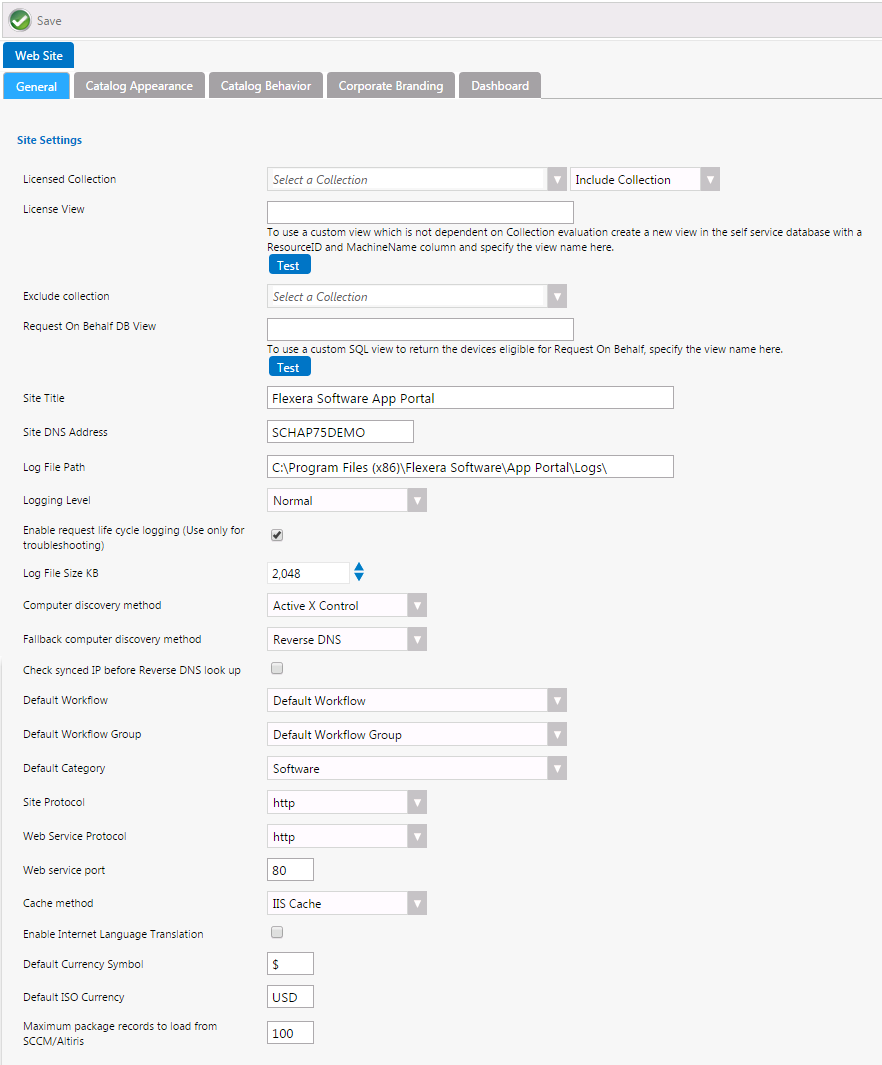
App Portal / App Broker for ServiceNow 2016 | Settings > Web Site
On the General tab of the Site Management > Settings > Web Site view, you specify the configuration settings of the App Portal website.

Settings > Web Site View / General Tab
The General tab of the Web Site view includes the following properties:
|
Property |
Description |
||||||||||||
|
Licensed Collection |
Use the Select a Collection list to identify a collection to set the scope of licensing. To use a collection to license, select a collection.
For more information, see Difference Between “Licensed Collection and “Exclude Collection”. |
||||||||||||
|
License View |
When using collection licensing, it is subject to collection update intervals. If you cannot update the collection at a schedule necessary, you can define a view in the App Portal database that will identify the licensed clients.
Enter the name of the view in the License View field. |
||||||||||||
|
Exclude collection |
This is the inverse of the Licensed Collection field Any members of the selected collection will be banned from App Portal activity. Difference Between “Licensed Collection and “Exclude Collection” When you use the Exclude collection list to exclude a collection from App Portal activity, this is not the same as selecting that same collection from the Licensed Collection list along with selecting Exclude Collection because the license count is not altered.
|
||||||||||||
|
Request On Behalf DB View |
To use a custom SQL view to display the devices eligible for Request On Behalf, specify the page name in this field, and then click Test to view the page. |
||||||||||||
|
Site Title |
The name of the site title as it appears on the browser title bar. |
||||||||||||
|
Site DNS Address |
Specify the DNS address of the site.
|
||||||||||||
|
Log File Path |
Specify the path to the log files. If you wish to use a different drive or folder, change the value here. Note • Be sure to include the trailing backslash. |
||||||||||||
|
Logging Level |
Specify the default logging level:
|
||||||||||||
|
Enable request life cycle logging |
Select this option to create individual log files for each App Portal request that lists all events that have occurred for that application. These log files will be stored in the following location: C:\Program Files (x86)\Flexera Software\App Portal\Logs\RequestLog This feature should only be turned on when performing troubleshooting. |
||||||||||||
|
Log File Size KB |
The data storage size for each log file created. |
||||||||||||
|
Specify how App Portal will determine the computer name.
|
|||||||||||||
|
Fallback computer discovery method |
If the primary Computer discovery method fails, the fallback discovery method will be used. |
||||||||||||
|
Check synced IP before Reverse DNS look up |
If this option is selected, App Portal will look into the local table for an IP address match for the machine. If the IP address is not found, App Portal then will perform a reverse DNS look up. Because viewing a local table takes less time than performing a reverse DNS lookup, selecting this option could speed up performance. By default, this option is not selected. |
||||||||||||
|
Default Workflow |
If you create a new catalog item and select the Require Approval for Install? option on the Global tab of the New Catalog Item dialog box, but do not add an approval workflow on the Approval Process tab, the approval workflow selected from this Default Workflow list will be used. |
||||||||||||
|
Default Approval Group |
Select a approval group to identify a group of approvers that would be used in a case where no approvers for a calculated workflow step could be identified (such as if you specified that a user’s manager is the approver for a workflow step, but that user does not have a manager). |
||||||||||||
|
Default Category |
Select the default category for a catalog item. |
||||||||||||
|
Site Protocol |
Specify if you want the protocol of the App Portal website to be http or https. |
||||||||||||
|
Web Service Protocol |
Specify if you want the protocol of the App Portal web service to be http or https. |
||||||||||||
|
Web service port |
If the Web Services are installed on a specific port, enter the port number here. |
||||||||||||
|
Cache method |
Specify the cache method to be used on the App Portal website:
|
||||||||||||
|
Enable Internet Language Translation |
Select to enable internet language translation on the Communication > Language Text view. |
||||||||||||
|
Default Currency Symbol |
Enter the default currency symbol to be used on the App Portal site, such the U.S. dollar sign or the British pound sign. |
||||||||||||
|
Default ISO Currency |
Enter the global currency code, from the ISO 4217 Currency Code list, for the currency that you want to use on the App Portal site. For example, enter USD for U.S. dollar, CAD for Canada dollar, or INR for India rupee. Note • The ISO Currency Code list is published by the ISO: International Organization for Standardization (http://www.iso.org). |
||||||||||||
|
Maximum package records to load from SCCM/Altiris |
Controls how many records from System Center Configuration Manager or Altiris that are initially queried and displayed on the listing when using the New Catalog Item Wizard. Tip • To search the entire server for a package or application, use the column filters above the listing. |
App Portal / App Broker for ServiceNow 2016 Administration Guide09 August 2016 |
Copyright Information | Flexera Software |